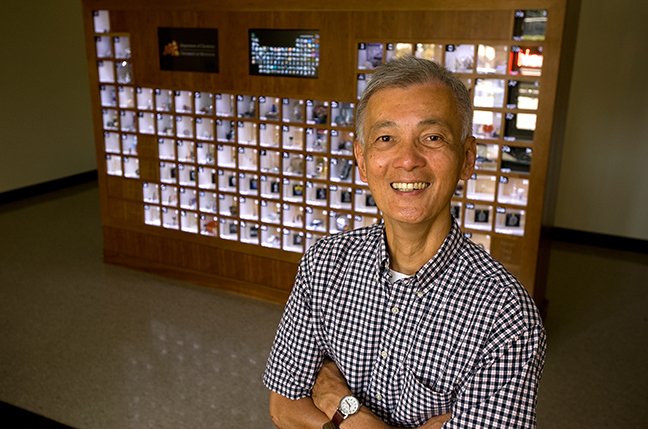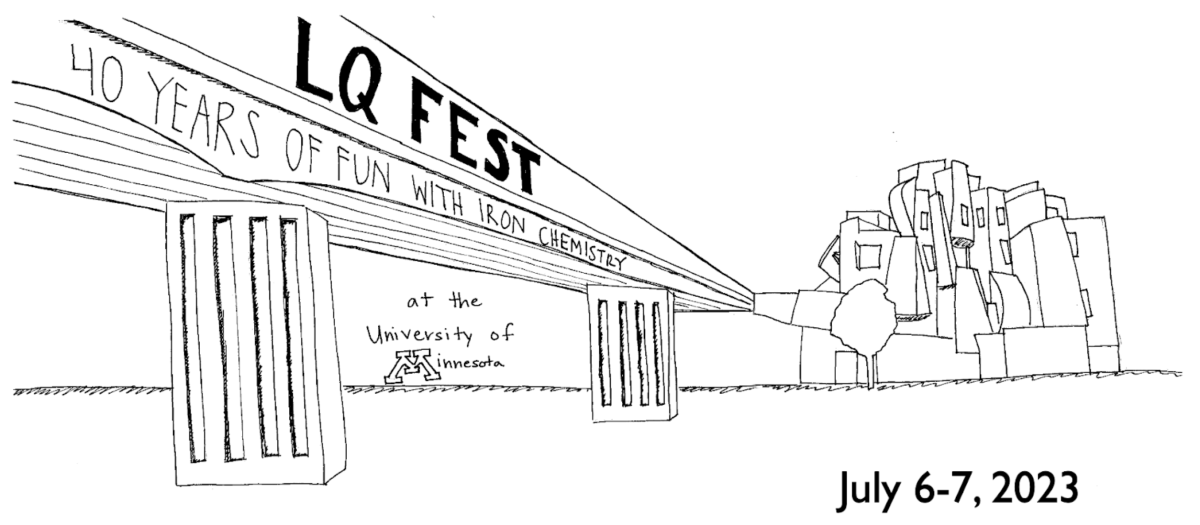Regents Professor Lawrence Que Jr. retires after 41 years at University of Minnesota

MINNEAPOLIS / ST. PAUL (8/13/2024) – Regents Professor Lawrence “Larry” Que Jr. retired from the Department of Chemistry on May 26th, 2024, after serving the University of Minnesota for more than four decades. Que’s tremendous impact in the field of bioinorganic chemistry earned him the title of Regents Professor in 2009 and election to the National Academy of Sciences in 2022.
The early years
Born and raised in Manila, Philippines, Que’s chemistry career began in the undergraduate chemistry program at the Ateneo de Manila University in Quezon City, Philippines. He earned his bachelor’s degree 1969 before arriving at the University of Minnesota to continue his chemistry education in the PhD program, which he completed in 1973. During his PhD, Que was advised by Louis H. Pignolet. Throughout his doctoral studies, Que used NMR spectroscopy to research intramolecular rearrangement reactions of transition metal complexes. He went on to conduct postdoctoral research under Professor Richard H. Holm at the Massachusetts Institute of Technology (1973-74) and under Professor Eckard Münck at the University of Minnesota (1975-77) which set the stage for his lifelong career in bioinorganic chemistry.
With his affinity for and expertise in iron chemistry firmly in place by 1977, Que started his independent career as an Assistant Professor of Chemistry at Cornell University. While at Cornell, Que utilized Resonance Raman spectroscopy to study dioxygenases; these enzymes would ultimately form the bedrock of Que’s research for the next 40 years.
Return to Minnesota
In 1983, Que returned to the University of Minnesota, this time as a member of the faculty. “Returning to Minnesota was the best decision I ever made for my career,” Que says. “I fell in love with this department during graduate school. I was very happy to have the opportunity to return, it’s been an honor to contribute to building our program for the last four decades.”
Described in more than 550 publications, Que’s research spanned the subfields of stereochemistry, catalysis, and crystallography. He established himself as an expert and innovator in bioinorganic chemistry, playing a pioneering role in understanding the function that nonheme iron centers play in dioxygen activation in biology. His work produced the first synthetic models for high-valent iron-oxo intermediates, which are crucial for understanding the electronic structures, spectroscopic properties, and reactivities of these units. Additionally, Que led efforts to create functional models for various iron oxygenases, including catechol dioxygenases, α-ketoglutarate-dependent oxygenases, and cis-dihydroxylating arene dioxygenases. These chemical tools aim to perform two specific types of chemical reactions that enable stereospecific alkane hydroxylation and highly enantioselective olefin cis-dihydroxylation. These advancements could lead to more environmentally friendly and sustainable alternatives to current heavy-metal oxidation catalysts. Que’s key dioxygen discoveries were published in ACS Chemical Reviews in 2004, in an article titled “Dioxygen Activation at Mononuclear Nonheme Iron Active Sites: Enzymes, Models, and Intermediates;” this paper would turn out to be the most cited work of his career. His prolific research portfolio garnered invitations to present more than 400 lectures around the world.
Over the years, Que’s research group focused on the topics of iron, oxygen, and biocatalysis in the area of bioinorganic chemistry, The group’s primary effort, involving a combination of biochemical, synthetic inorganic, and spectroscopic approaches, was aimed at elucidating the oxygen activation mechanisms of nonheme iron enzymes, designing functional models for such enzymes, trapping and characterizing reaction intermediates, and developing bio-inspired oxidation catalysts for green chemistry applications. Que advised 55 graduate students and 80 postdoctoral researchers over the course of his career. Over 50 Que Group alumni have tenure-track or tenured faculty positions in colleges or universities.
“Iron Man”
Que’s critical dioxygen research earned him the title of Regents Professor in 2009. A quote from the citation for the award reads “Undoubtedly, Professor Que is currently the top bioinorganic chemist in the world. In his chosen field, oxygen activation of iron-containing enzymes and biomimetic compounds, his group, in my estimation, is at least three years ahead of his closest competitors. Almost single-handedly he has developed the major fraction of the synthetic chemistry of iron in high-oxidation states. This chemistry is vital to our understanding of many processes in biochemistry, to the development of new drugs, and most importantly, to developing a green chemistry that can alleviate the problems caused by pollutants and pathogens that afflict human health." The Regents Professorship is the highest honor the University of Minnesota bestows on its faculty. The title recognizes faculty who have made exceptional contributions to the University through teaching, research, scholarship, or creative work, and contributions to the public good.

Beyond his research success, Que demonstrated significant commitment to service to the University across his career. He is credited with establishing the University of Minnesota as a world-renowned center of excellence in bioinorganic chemistry. He organized the International Conference on Oxygen Intermediates in Nonheme Metallobiochemistry (1996) and the Ninth International Conference on Biological Inorganic Chemistry (1999). From 1999 to 2002 – and again from 2008 - 2012 – he served as the inaugural PI on the National Institutes of Health Chemistry-Biology Interface Training Grant that brings faculty and students from various departments together. He also led the effort to establish the University of Minnesota Center for Metals in Biocatalysis, which allowed faculty and students from multiple units to collaborate in exploring the roles of metals in biology.
Que was longest standing editor-in-chief of the Springer Journal of Biological Inorganic Chemistry (JBIC), serving the journal for 20 years. JBIC – the official journal of the Society of Biological Inorganic Chemistry since 1996 – is a peer-reviewed journal promoting the field of biological inorganic chemistry internationally. The publication aims to provide insight into systems of metals in biology at biochemical, molecular, and cellular levels.
For his research, service, and mentorship, Que has been honored with many awards over the course of his career. These honors include the 3M/Alumni Distinguished Professorship (1999), the National Institutes of Health MERIT Award (2000), the UMN Distinguished Teaching Professorship (2000), the Royal Society of Chemistry Inorganic Reaction Mechanisms Award (2011), and the American Chemical Society Award in Inorganic Chemistry (2017). He was also elected a fellow of the American Association for the Advancement of Science in 2001, a fellow of the Royal Society of Chemistry in 2008, and a fellow of the American Chemical Society in 2011. In 2022, Que was elected to the National Academy of Sciences. Membership in the NAS is one of the highest honors given to a scientist or engineer.
LQ Fest: 40 Years of Fun with Iron Chemistry at the University of Minnesota

In July 2023, the Department of Chemistry hosted LQ Fest: 40 Years of Fun with Iron Chemistry at the University of Minnesota in honor of Que. 19 of Que’s collaborators, mentees, and even his daughter, Emily Que – who is an Associate Professor of Chemistry at the University of Texas at Austin – presented lectures, stories, and memories related to Que’s research and career. When recalling the event he said “I’ve loved my job. I’ve loved the people that I’ve worked with. I spent the last 50 years of my life dedicated to chemistry, and I never looked back. The event was a wonderful opportunity to get together with many people that I’ve cared about to celebrate my career.”
The next chapter
“Nothing changes, really. I’ve always thought about chemistry, and I’ll continue to think about chemistry all the time,” Que said. In this next chapter of life, Que is adopting a come what may attitude. He says he is looking forward to spending more time with his grandchildren in Texas and embarking on new adventures with his wife.